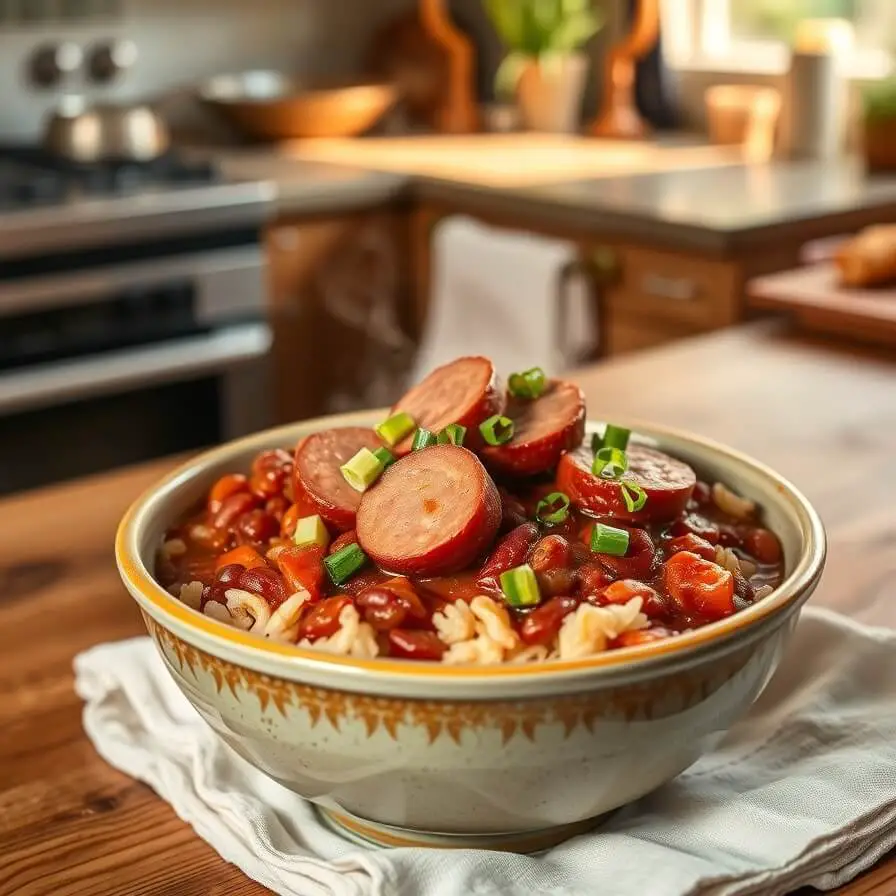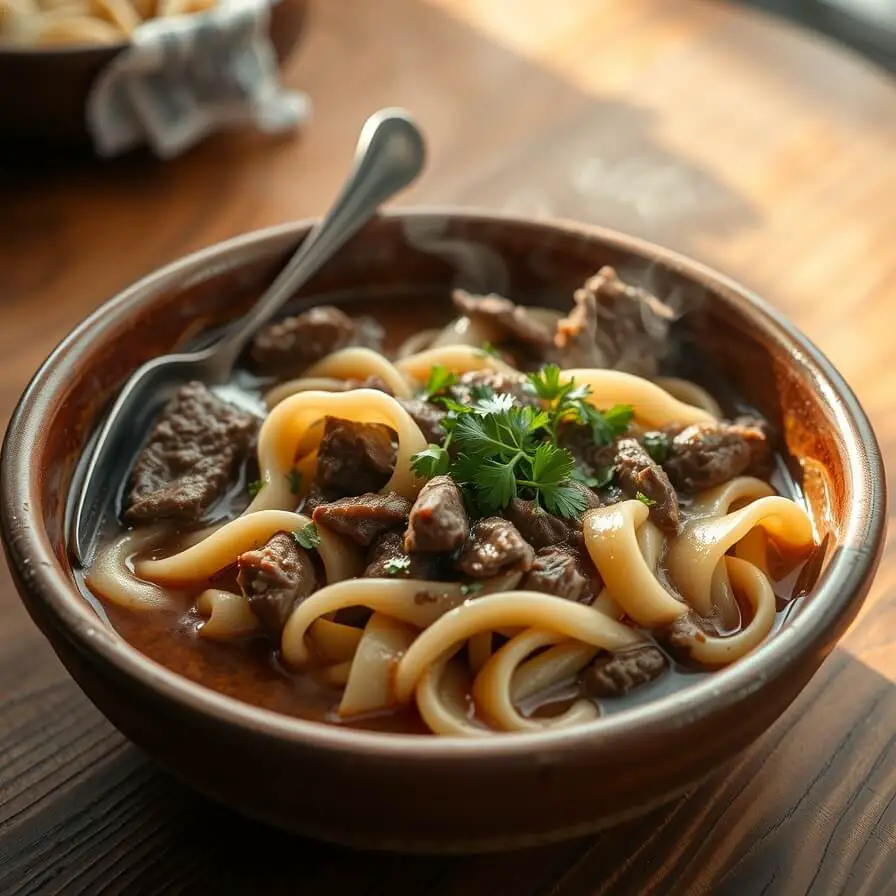Red Beans and Rice Recipe
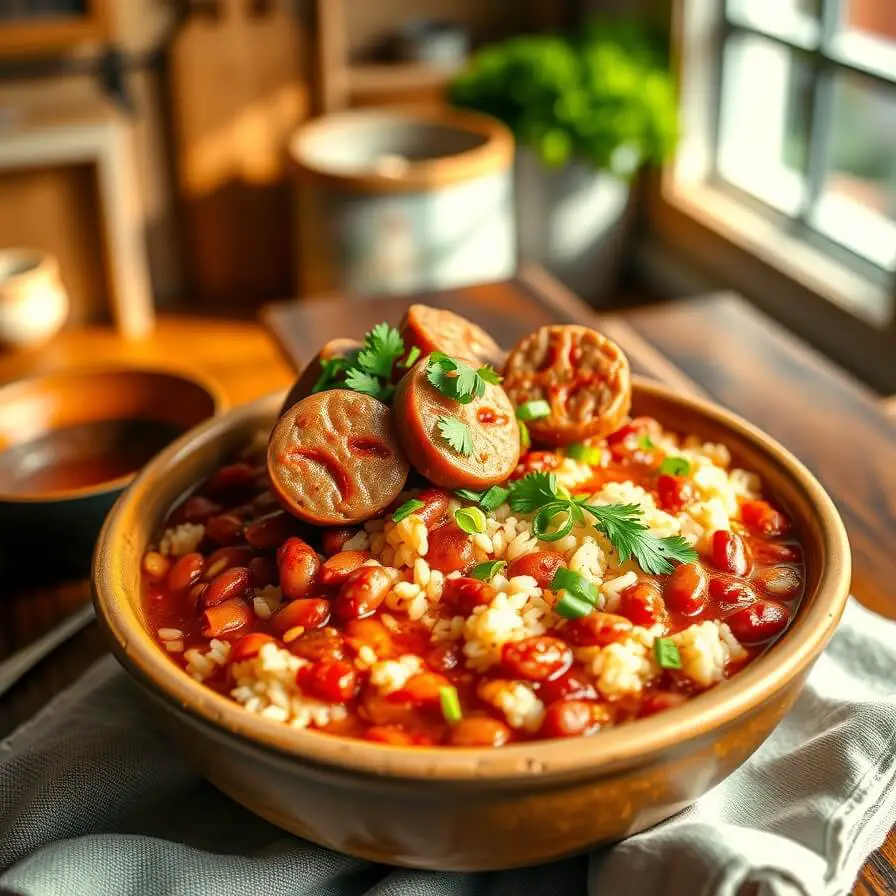
I still remember the first time I truly understood the magic of red beans and rice. I was visiting my aunt in New Orleans one humid July, and the aroma of onions, bell peppers, and smoky sausage wafted from her kitchen long before I even knocked on the door. She was humming a familiar tune, stirring a big pot of beans that had been simmering all morning. I pulled up a chair, impatiently asking when I could taste it, and she winked: “Patience, child. The secret’s in letting it speak for itself.”
By the time I finally dug in, the beans were tender, the rice perfectly fluffy, and every bite felt like it had absorbed the soul of the city. I wanted to recreate that moment at home, but my first attempts were… let’s just say, humbling. Too salty, too mushy, or missing that deep, smoky warmth. It took a few tweaks and a lot of taste-testing, but eventually I nailed it—and now, this dish is a weekend ritual in our house. Even my picky husband will go back for seconds (and thirds) without complaint.
Red beans and rice is more than just a meal; it’s comfort on a plate, a reminder of family kitchens and slow Sundays. But it’s also surprisingly forgiving. Once you understand a few flavor secrets, you can make it your own—adding heat, swapping proteins, or even making it entirely vegan without losing its heart.
The Secret Behind Its Flavor
What makes this dish unforgettable isn’t just the beans or the rice—it’s the harmony of aromatics, spices, and slow-cooked patience. A base of onions, bell peppers, and celery—what New Orleanians lovingly call the “holy trinity”—forms the backbone. Add garlic, smoked sausage, a dash of paprika, and a hint of cayenne, and suddenly the beans themselves transform into something silky, smoky, and deeply savory.
The key, though, is time. Red beans need to simmer low and slow. A rushed boil may cook the beans, but it won’t coax out the richness that makes every spoonful sing. And don’t underestimate the water-to-bean ratio: too little, and they’ll scorch; too much, and the flavor dilutes. Watching them bubble gently while the kitchen fills with that warm, comforting scent is half the joy of this recipe.
I’ll admit, my first batch burned a little because I got distracted talking to my kids. But even then, the smell of the smoky sausage and simmered beans filled the room and reminded me that a little patience—and attention—is all it takes to bring this dish together perfectly.
Ingredients in Context
Here’s where the fun begins—shopping and selecting ingredients. A good red beans and rice starts with, you guessed it, red beans. I usually reach for dry beans—they’re more flavorful than canned, and I love soaking them overnight to reduce cooking time. But in a pinch, canned beans can work; just rinse and drain them thoroughly.
The sausage is where you can customize the dish. Andouille sausage gives a smoky, slightly spicy kick, but kielbasa or even smoked chicken sausage work beautifully. If you’re avoiding pork, smoked turkey sausage is a solid alternative, and it still lends that depth of flavor.
For the holy trinity, pick fresh, firm vegetables. Bell peppers should be vibrant and crisp; celery should snap when you break it; onions should have a strong, sweet scent. These aren’t just filler—they’re the flavor base that transforms simple beans into a soulful dish.
Rice deserves attention, too. Long-grain white rice is traditional and keeps fluffy, but you can experiment with brown rice for a nuttier flavor or jasmine rice for a subtle fragrance. Just remember that different rices may need slight adjustments in water ratio and cooking time.
Step-by-Step Instructions
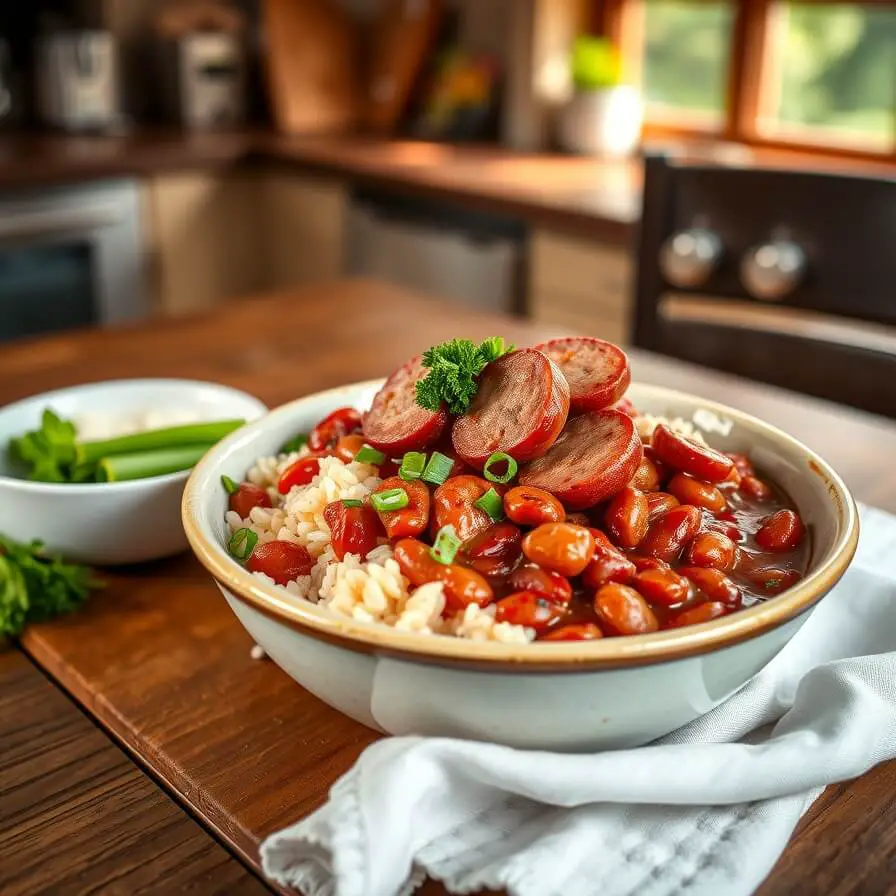
Now for the heart of the kitchen work. I like to treat this part almost meditatively, tasting, smelling, and adjusting as I go.
Start by rinsing your beans thoroughly, picking out any tiny stones or debris. Soak overnight if using dried beans—this makes them tender and easier to digest.
In a heavy-bottomed pot, heat a splash of oil over medium heat. Add your chopped onions, bell peppers, and celery. Cook until the onions are translucent and the peppers are tender, about five to seven minutes. At this stage, the aroma is intoxicating—the room smells like a cozy Sunday morning.
Add the garlic and cook for another minute, being careful not to let it burn. Then, slice your sausage into bite-sized pieces and toss them into the pot. Let them brown slightly, stirring occasionally.
Now comes the beans. Add them to the pot with enough water or low-sodium chicken stock to cover. Season generously with salt, pepper, paprika, and a pinch of cayenne if you like heat. Bring everything to a gentle simmer, cover partially, and let it cook for about 90 minutes to two hours. Stir occasionally, tasting for seasoning as it cooks. You’ll notice the beans breaking down slightly, creating that luscious, creamy texture.
About 15 minutes before the beans are done, start cooking your rice according to package instructions. Fluff it with a fork and keep it warm.
Once the beans are tender and the sauce has thickened to your liking, serve them spooned over a bed of rice. A sprinkle of fresh parsley or green onions on top adds a pop of color and freshness.
Substitutions & Adaptations
One of the joys of red beans and rice is how adaptable it is.
- Vegan: Skip the sausage entirely and add smoked paprika and liquid smoke to give depth. You can also toss in sautéed mushrooms for a meaty texture.
- Gluten-free: Naturally, beans and rice are gluten-free, but check sausage labels to ensure no fillers.
- Kid-friendly: Reduce or omit the cayenne. Mild paprika or smoked paprika keeps the flavor rich without the heat.
- Quick version: Canned beans and pre-cooked sausage can cut the simmering time in half—still flavorful, just less complex.
One trick I’ve learned is to taste halfway through cooking. Adjusting the seasoning and texture at this stage makes a huge difference, especially if you’ve swapped ingredients.
Pairings & Serving Ideas
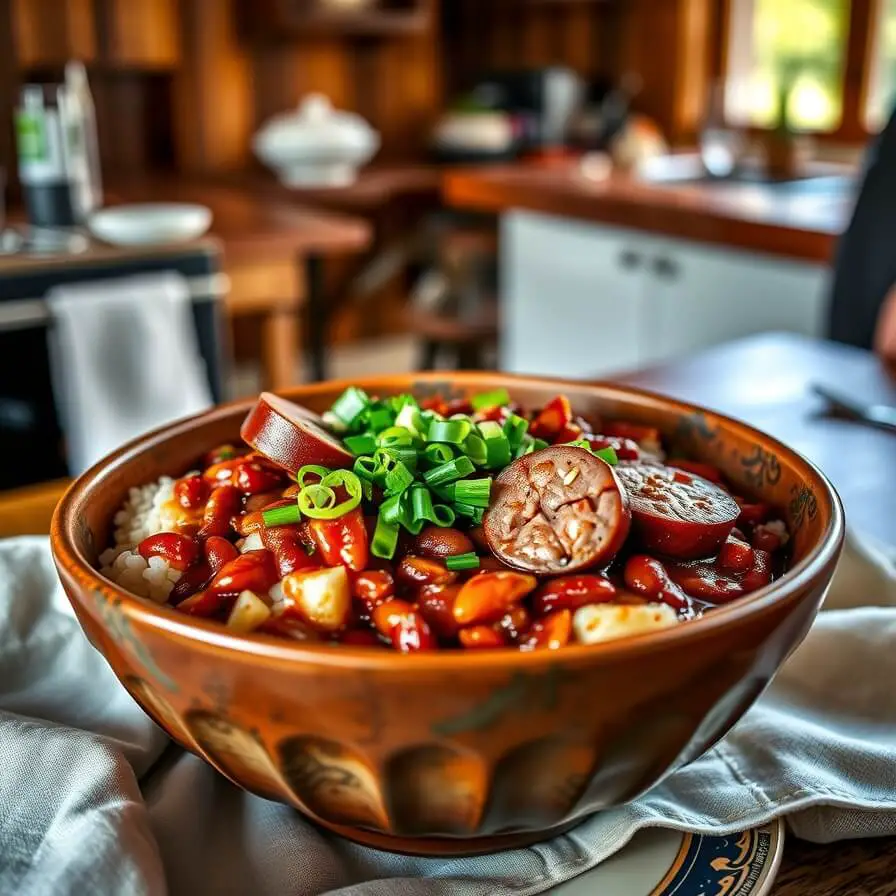
Red beans and rice is a full meal on its own, but a few side touches elevate it beautifully. A simple green salad with a tangy vinaigrette balances the richness of the beans. Crusty French bread is perfect for soaking up every last drop. And for those who love a little crunch, fried okra or roasted asparagus works wonders.
Leftovers, if there are any, are even better the next day. The flavors meld, the beans thicken slightly, and reheated rice retains its fluffiness if stored separately. I often pack some for lunch, and it tastes like a warm hug in a bowl.
Pro Tips & Mistakes to Avoid
Even though red beans and rice seems simple, a few missteps can turn it from comfort food to kitchen frustration. I’ve learned most of these the hard way, so here are my tried-and-true tips.
Don’t rush the simmering
The biggest rookie mistake is trying to speed things up with high heat. Yes, the beans will cook faster, but the flavor won’t develop, and you risk splitting the beans into a mushy mess. Slow and steady is the way to go. I once walked away for a phone call and returned to a pot that was sticking to the bottom. Lesson learned: keep the heat low, stir occasionally, and enjoy the aroma filling your kitchen.
Season in layers
Adding salt and spices only at the end is tempting, but you’ll end up with a flat-tasting dish. Season early and adjust gradually. I like to taste every 30 minutes, tweaking salt, pepper, and heat. It makes the final product perfectly balanced, without a single overwhelming note.
Watch the liquid
Red beans need to be covered by liquid as they cook, but too much water will dilute the flavor. Start with just enough to cover, and add more only if necessary. This is especially important if you’re using dry beans—they expand significantly as they soak and cook.
Mind your sausage
Sausage is a star here. Overcooking can make it tough, undercooking leaves it bland. Slice it thick enough so it retains juiciness, and let it brown slightly before simmering with the beans. If you’re using a pre-cooked sausage, just add it in the last 20 minutes of cooking.
Don’t skip resting
Once cooked, let the beans sit off the heat for 5–10 minutes before serving. The flavors meld, and the texture firms up slightly—perfect for spooning over fluffy rice.
Storage & Make-Ahead Tips
Red beans and rice is wonderfully forgiving when it comes to leftovers. Here’s how I handle it:
Refrigeration
Store beans and rice separately in airtight containers for up to 4 days. This keeps the rice from becoming mushy and lets you reheat each component evenly. When ready to serve, gently warm the beans on the stovetop, and microwave the rice with a splash of water to fluff it back up.
Freezing
This dish freezes beautifully. I usually portion beans without rice into freezer-safe containers. They keep for up to 3 months. To reheat, thaw overnight in the fridge, then warm slowly on the stove, stirring occasionally. Add freshly cooked rice for the best texture.
Make-ahead
For busy weekdays, you can make the beans a day or two in advance. The flavors actually improve after sitting, making it a fantastic option for meal prep. Just reheat gently and serve over freshly cooked rice.
FAQs
Can I use canned beans instead of dry beans?
Absolutely. Canned beans are a great shortcut. Rinse them well to remove excess sodium, then reduce the simmering time since they’re already cooked. You’ll still get a rich, comforting flavor.
How spicy is this recipe?
It’s mildly spicy, thanks to paprika and a pinch of cayenne. If your family prefers heat, add more cayenne or a dash of hot sauce. For kids or sensitive palates, reduce the cayenne or skip it entirely.
Can I make it vegetarian?
Yes! Skip the sausage and use smoked paprika or liquid smoke for depth. You can also toss in mushrooms or roasted vegetables for a heartier version. The beans themselves are hearty enough to keep it satisfying.
What rice works best?
Long-grain white rice is traditional and keeps fluffy, but jasmine or brown rice works too. Brown rice will need slightly more water and longer cooking time.
Can I prepare it in a slow cooker?
Definitely. Sauté the aromatics and sausage first, then combine with soaked beans and broth in a slow cooker. Cook on low for 6–8 hours or until beans are tender. Adjust seasoning toward the end.

Red Beans and Rice Recipe
- Total Time: 2 hours 20 minutes
- Yield: 6 1x
- Diet: Gluten Free
Description
Discover the ultimate comfort food with this classic red beans and rice recipe. Slow-simmered red beans, smoky sausage, and fluffy rice come together in a flavorful, hearty dish perfect for family dinners or meal prep. Learn tips, substitutions, and serving ideas to make it your own.
Ingredients
- 1 lb dried red beans (or 3 cans, drained and rinsed)
- 1 tbsp olive oil
- 1 large onion, diced
- 1 green bell pepper, diced
- 2 celery stalks, diced
- 3 cloves garlic, minced
- 1 lb smoked sausage (Andouille, kielbasa, or turkey sausage), sliced
- 6 cups low-sodium chicken or vegetable broth
- 1 tsp smoked paprika
- ½ tsp cayenne pepper (optional)
- Salt and black pepper to taste
- 3 cups cooked long-grain white rice
- Fresh parsley or green onions for garnish
Instructions
- Prep the beans: Rinse dried beans, removing debris. Soak overnight if using dried.
- Cook aromatics: Heat olive oil in a heavy pot over medium heat. Sauté onions, bell peppers, and celery until tender. Add garlic and cook 1 minute.
- Add sausage: Brown sliced sausage in the pot with aromatics.
- Simmer beans: Add beans, broth, smoked paprika, cayenne, salt, and pepper. Bring to a gentle simmer. Cover partially and cook 90–120 minutes, stirring occasionally. Adjust liquid if needed.
- Cook rice: Prepare rice separately according to package instructions.
- Finish & serve: Spoon beans over rice, garnish with parsley or green onions. Serve warm.
Notes
- Adjust seasoning gradually throughout cooking.
- For vegan version, skip sausage and use smoked paprika or liquid smoke for depth.
- Beans can be stored separately from rice for best texture.
- Flavors improve if made a day ahead.
- Prep Time: 20 minutes
- Cook Time: 2 hours
- Category: Main Dish
- Method: Creole / Southern
- Cuisine: Stove-top simmer
Nutrition
- Serving Size: 6
- Calories: 350
- Sugar: 3g
- Sodium: 550mg
- Fat: 12g
- Saturated Fat: 4g
- Unsaturated Fat: 8g
- Trans Fat: 0g
- Carbohydrates: 42g
- Fiber: 9g
- Protein: 18g
- Cholesterol: 35mg

